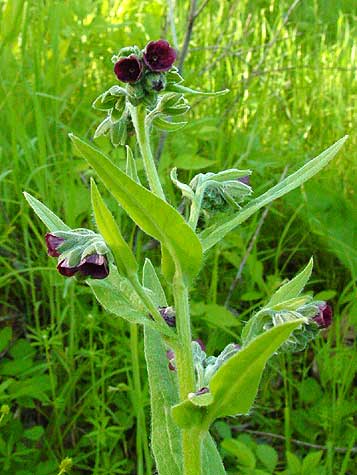Houndstongue forms a rosette in its 1st year with softly pubescent leaves 4 to 12 inches (10-30 cm) long and 0.8 to 2 inches (2-5 cm) wide. It has a thick, black, branching taproot, extending to depths > 40 inches (100 cm). An individual plant consists of 1 or several rosettes on a single root system. Flower stems, 12 to 48 inches (30-120 cm) tall, are produced the 2nd year, or sometimes later. The upper part of the stem is branching. Stem leaves are generally broadest near the base and narrower towards the tip. Houndstongue inflorescences have up to 35 but usually no more than 10 flowers each and are axillary to leaves or terminating short branches. Each flower can produce up to 4 fruits. The fruits are nutlets, the surfaces of which are flat and densely covered with small, barbed hooks (glochidia) that facilitate dispersal by animals.

Houndstongue rosettes can withstand drought stress, enabling the plant to survive water deficits and to delay flowering until conditions are favorable. The thick, deep taproot can exploit lower soil strata for water and nutrients. The root also serves as an underground food reserve which may offer protection against winter injury.
Houndstongue often occurs in dense stands, but may also occur as a small but regular proportion of regional flora. Seedlings are usually strongly clustered around parent plants in densities of up to 405 seedlings per ft2 (4500/m2). Houndstongue may grow as an isolated plant or at densities up to 1 individual per ft2 (8/m2) on dunes in England. On coastal dunes in the Netherlands, its abundance ranges from rare to abundant. Vesicular-arbuscular mycorrhizae are usually present on houndstongue roots.
King's American Dispensatory
The leaves and root of Cynoglossum officinale, Linné.
Nat. Ord.—Boraginaceae.
COMMON NAME: Hound's tongue.
Botanical Source.—This is a biennial plant, with an erect, silky-pubescent stem, growing from 1 to 2 feet in height. The leaves are hoary, with soft down on both sides, lanceolate, acute, and entire-radical ones alternate at the base, petiolate; cauline ones sessile, clasping, with rounded or slightly heart-shaped bases. The flowers are in terminal, panicled clusters, recurved at the end; the calyx downy and 5-parted; the corolla reddish-purple, short, funnel-form, and vaulted; the throat or orifice closed by 5 converging, convex scales. Stamens shorter than the corolla. Achenia depressed, fixed laterally to the style; seeds rough, with hooked prickles.
History.—This plant is met with in Europe and this country, growing in waste grounds and road-sides; its name is derived from the peculiar form of the leaf; it bears purple flowers in June and July. The root is preferred to the leaves; it has a heavy, mouse-like, unpleasant odor, which is removed by desiccation, and a mawkish, amarous taste. The fresh plant is much more active than the dried.
Action, Medical Uses, and Dosage.—Anodyne, demulcent, and astringent, and has been used in coughs, catarrhs, hemoptysis, diarrhoea, and dysentery. Externally, in the form of a poultice, it has been found highly beneficial in scrofulous tumors, burns, goitre, and may be applied to recent contusions or inflammations with much advantage; also to remove the pain and soreness attending irritated, bruised, or chafed parts, giving complete and immediate relief, especially in excoriation of the feet from much traveling. The tincture, or the application of bruised fresh leaves will remove the swelling and ecchymosis consequent upon severe blows or bruises. Paralyzing effects are said to be produced by it in the vertebrate animals.
 Hound's Tongue
Hound's Tongue